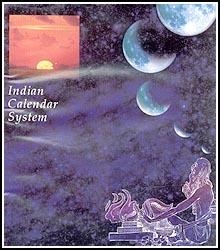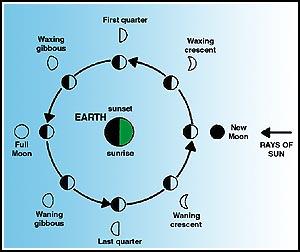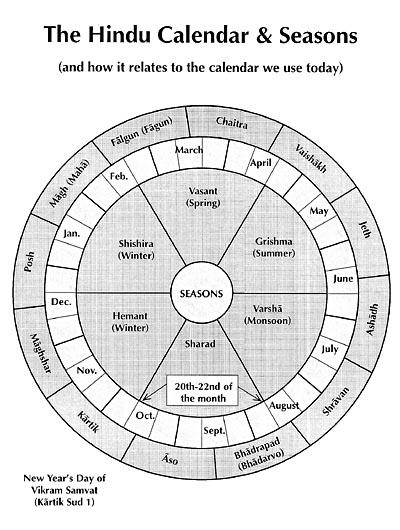
At the turn of the new millennium
the Western date adorned three zeros - the year 2000.
But for the Indian dating system, this historic moment passed 56 years ago;
It was 2056 according to the Indian calendar!
Why do these two calendars differ? And how? |
How & Why Calendars Began
Since the dawn of creation, man has been wondering and pondering upon the secrets the stars enshrine. Man's innate inquisitiveness has led him to prolonged and detailed observations in a quest to reveal the underlying laws of the wide variety of astronomical phenomena.
As man developed into a food-producer, growing crops for himself, his observations soon led him to relate agricultural operations to the sun and the moon. From this, he could determine the cyclic seasons. His 'daily' affairs of work and rest led him to appreciate the regularity of day and night. As he experienced aging, he also discerned 'age' as a factor to establish seniority in the social hierarchy. And so, in the natural course of time, Time itself called for some sort of framework. This intangible commodity that was governing the lives of everyone needed to be 'calendar-ized'. From this need was born the calculation and computation of Time.
Findings from the ancient Egyptian and Mesopotamian civilizations show the abiding interest of the times in chronology and astronomy. But the oldest, largest, and by far the most sophisticated of the great ancient cultures, the Indus Valley Civilization(of india), proved to be far ahead in terms of chronological and astronomical acumen. It is noted that a special class of professional astronomers, called nakshatra-darshaks or 'star-gazers', meticulously observed and recorded the phases of the moon in reference to fixed stars - called nakshatras, or asterisms. This method of calculation, and its precision, sharply distinguishes Indian astronomy from the astronomy of all other countries.
Western & Indian Calendars: The Difference
The principal factor distinguishing the Western calendar and the Indian calendar is their frame of reference. The Western calendar is based on the sun, in which a year is the time required for the earth to complete one orbit around the sun. Modern instruments have measured this to be precisely 365 days 5 hours 48 minutes and 46 seconds. This solar year comprises of 12 arbitrarily designated months - all of which have either 30 or 31 days, except February, which has 28 in common years and 29 every fourth year (leap year).
The Indian calendar is ingeniously based on both the sun and the moon; it uses a solar year, but divides it into 12 lunar months. A lunar month - or more accurately, a synodic month - is the time required for the moon to orbit once around the earth and pass through its complete cycle of phases. Furthermore, these months are formulated in accordance with the successive entrances of the sun into the 12 rashis - signs of the zodiac, i.e. the 12 constellations marking the path of the sun.
A brief glance at the history and workings of both the Western and Indian calendars will help explain why the Indian system is so precise and scientific.
Western Calendar: History & Shortcomings
The present-day Western calendar evolves from the ancient Roman calendar. (The name of its first month, Kalendea, is probably how the term 'calendar' arose.) In 46 BCE, Julius Caesar authorized a reformed system of dating, which came to be known as the Julian Calendar. Caesar, advised by his Greek astronomer Sosigenes, took the length of the solar year to be 365¼ days. To compensate for errors that had accumulated over previous years, Caesar decided to allocate 445 days to the first year. Not surprisingly, 46 BCE later became infamous as 'The Year of Confusion'. Unfortunately, because of other misunderstandings, the new calendar was not in smooth operation until 8 CE. But even more unfortunate was the miscalculation proved by St. Bede the Venerable, an Anglo-Saxon monk. He announced in 730 CE that the 365¼ day Julian year was 11 minutes and 14 seconds too long. By the 16th century, the accumulative effect of the error had shifted the dates of the seasons by 14 days; a displacement of almost a day a century.
In 1582, Pope Gregory VIII ordained a reformation to restore the calendar to its 'correct' schedule. However, he estimated only a 10-day adjustment. Calculations were based, rather arbitrarily, on the dates of the vernal (spring) equinox; in 325, it occurred on 21 March, but in 1582, it occurred on 11 March. And so the change was effected by advancing the calendar 10 days on 4 October 1582. The following day became 15 October 1582!
Non-Catholic countries were slow to accept the new, Gregorian calendar; Russia and Greece waited until this century to convert. England, too, adopted it only in 1752.
Many Christians abhorred the new system. For one thing, New Year's Day, which had until then been celebrated on 25 March, had to be moved to 1 January. The major issue of discussion, though, was Easter Sunday. The Christian ecclesiastical (church) calendar was originally bound by the belief that Jesus' resurrection was on a Sunday, and so Easter should always fall on a Sunday. Later, it was decreed that the Sunday following the first full moon after the spring equinox should be regarded as Easter Sunday. Despite all this, though, the date still varies from astronomical reckoning because certain important factors of the lunar period were not considered.
Another interesting point is the year the present-day Gregorian calendar commences from, the 'year of grace', which signifies the year in which Jesus was born, and the beginning of the Christian Era. The year is followed by the initials 'AD' which stand for 'Anno Domini', Latin for 'in the year of our Lord'. But the Bible clearly gives reference to Jesus being born during the reign of King Herod, who died in 4 BC! All of Christendom now universally accepts that Jesus was born between 8-4 BC.
History & Precision Of The Indian Calendar
References from Vedic literature show that Indian chronology in its primary stages existed thousands of years before the Christian Era. The earliest traces of Indian chronology (science of Time) and chronometry (scientific measurement of Time) belong to the Vedic period. Knowledge of planetary motions, constellations, eclipses, solstices, seasons, etc. has existed since the beginning of the Vedic Age.
A method of distributing time into various periods such as days, fortnights, months and years was adopted for the purposes of civic life, these divisions being intimately connected with the affairs of the people. And because of the very fact that the Indian calendar was devised to serve the affairs of day-to-day living, it was allowed the freedom of being both lunar and solar. Notes Shivanath Zarakhandi in his study of Indian astrology, Bharatiya Jyotisha, "From the period of the Rig Veda, months were lunar, but years luni-solar."
This means that there was a constant correlation between the solar year and its monthly lunar divisions.
A lunar month (or synodic month since it is also relative to the sun) is precisely 29 days 12 hours 44 minutes and 3 seconds long. Twelve such months constitute a lunar year of 354 days 8 hours 48 minutes and 36 seconds. To help the lunar months coincide with the solar year, the practice arose of inserting intercalary (extra) months. In general, 60 solar months = 62 lunar months. And so an extra month, called the Adhik Mas, is inserted every 30 months, approximately every 2½ years. Such a practice was prevalent even in Vedic times. An intercalary month mentioned in the Rig Veda {Vedamãso dhrutavrato dvãdasha prajãvatah; vedã ya upajãyate. (I/25:8)} proves that the month was added to preserve the correspondence between a whole solar year and the 12 lunations.
Such adjustments assure that the seasons, festivals, etc. retain their general position to the solar year. That is why, for example, Diwali always falls between late October and early November. In stark comparison is the Islamic calendar. It, too, is a lunar-based calendar. But the omission of such intercalary adjustments mean that Islamic festivals such as Eid, Ramadan, etc. fall at different times of the year every year.
Lunar days in the Indian calendar are called tithis. They, too, are calculated very scientifically using the difference of the longitudinal angle between the position of the sun and the moon. Because of this, tithis are allowed to vary in length. Consequently, the tithi may or may not have changed by the time the day has changed, at sunrise. And that is why we find at certain times a tithi being 'omitted', and at certain times, two consecutive days sharing the same tithi.
All this, together with the fact that ancient Indian astronomers had terms for measurements of time as minute as 34,000th a second, proves the Indian system of dating to be unarguably precise and above all, scientific.
So accurate and practical is the Indian calendar system that it also became popular in Nepal, Tibet, Thailand and Java, as well as the Islamic West and other regions of south-east Asia. Several Indian texts on Astronomy are known to have been translated into Chinese, especially during the Sui and Thang Dynasties (581-907CE). While Indian astronomers and mathematicians travelled widely to spread their knowledge, foreign astrologers and astronomers were also attracted to India from as far afield as Arabia and Persia. David Pingree notes this positive influence in his extensive study of the history of Indian literature. He writes in Jyotishastra - Astral and Mathematics Literature, Volume IV, "The basic traditions of Indian astronomy imposed on these external [Babylonian, Greek and Islamic] systems its peculiar stamp, and transformed the science of Mesopotamia, Greece and Iran to something unique to India."
How The Indian Calendar Works
In the Indian calendar, seasons follow the sun; months follow the moon; and days, both the sun and the moon.
In ancient texts, the moon has been referred to as the masa-krut or 'month-maker', confirming that the interval between two consecutive new moons or full moons was the basis of calculating the length of a month. Two systems of month-reckoning were prevalent in different parts of India at different times: the purnimanta system - in which the month ends with a full moon; and the amasanta system - in which the month ends on the darkest night of the month, a 'no moon' night. At present, Gujarat and most of India adhere to the amasanta system, i.e. in which a new month begins with a new moon.
Each month is divided into two parts, called pakshas: the shukla (or sud) paksh, and the krishna (or vad) paksh. Each refer to the 'bright half' and the 'dark half' of one lunation, respectively; i.e. wherein the moon waxes (progresses) from a new moon to a full moon, and thereafter wanes (regresses) from a full moon to a 'no moon'.
Tithis & Phases Of The Moon

The moon, maintaining a mean distance of 384, 000km, orbits the earth every 29.53 days - in synchronous rotation, i.e. always keeping the same face towards the earth.
The drawings in the outer circle show the moon as viewed from the earth at its various phases.
Each paksh (half) is further divided into 15 tithis (lunar days) which follow the names of the Sanskrit ordinals (numbers). [Refer to table] This system in the Indian calendar of dissecting a month equally into two, and again into 15, is a truly ingenious devise - both logical and simple, and indeed, characteristically Indian.
|
Names Of The Tithis
|
|
Tithi
|
Sanskrit Name
|
Gujarati Name
|
|
1
|
Prathama
|
Padvo or Ekam
|
|
2
|
Dwitiya
|
Bij
|
|
3
|
Trutiya
|
Trij
|
|
4
|
Chaturthi
|
choth
|
|
5
|
Panchami
|
Pancham
|
|
6
|
Shashthi
|
Chhath
|
|
7
|
Saptami
|
Satam
|
|
8
|
Ashtami
|
Atham
|
|
9
|
Navami
|
Nom
|
|
10
|
Dashami
|
Dasham
|
|
11
|
Ekadashi
|
Agiyaras
|
|
12
|
Dwadashi
|
Baras
|
|
13
|
Trayodashi
|
Teras
|
|
14
|
Chaturdhi
|
Chaudash
|
|
15
|
Purnima
|
Punam
|
|
30*
|
Amavasya
|
Amas
|
the first 15 tithis of the sud paksh have passed, i.e. from sud 1 to (sud) Punam, the tithis of the vad paksh begin again from 1, i.e. Punam is followed by vad 1, and so forth. But after vad 14, Amas is denoted as '(vad) 30' signifying it to be the last tithi of the month. Thus, 'Chaitra sud 9' is read as Chaitra sud nom; and 'Magshar sud 8' is read as Magshar sud atham. But 'Kartik sud 15' is read as Kartik sud Punam, or Kartiki Punam; and 'Posh vad 30' is read as Posh vad Amas.
The 12 lunar months of a solar year are divided into six rutus (seasons), each comprising of approximately two months. Since the seasons are solar based, each of the six seasons - Sharad (late monsoon), Hemant (early winter), Shishir (winter), Vasant (spring), Grishma (summer) and Varsha (monsoon) - commence around the 21st date (± 2) of each even month of the Western calendar.
Days and nights, too, are reckoned according to the sun. Traditionally, and quite logically it seems, a new day begins at sunrise (not midnight), and the night, at sunset (not after noon or evening).
Correlating Indian And Western Calendars
In addition to the natural reckoning of days, months, seasons, and the year, a continuously running era is required for the recording of dates.
History reveals that India has passed through a number of eras that came into vogue in different regions at different times, each differing slightly in the commencement of their years and/or the completion of their months.
North India, except Bengal, generally accepted a year commencing at the month of Chaitra, while a year commencing in Ashadh was prevalent for some time in the Gujarat regions of Kutch and western Saurashtra. (This is the dating system used in the Vachanamrut) Presently, though, the universally accepted system throughout most of India is a year beginning on the first day of Kartik, and a month beginning with a new moon.
The era currently popular in the Indian calendar is the Vikram Era, or Vikram Samvat as it is called, which began in 57 BCE. To calculate the corresponding year of the Common Era, 57 years should be subtracted from the Indian year if the date falls between the beginning of the Indian year and the end of the Western year, i.e. between Kartik sud 1 and 31 December. If the date falls between the beginning of the Western year and the end of the Indian year, i.e. between 1 January and Aso vad 30, then only 56 years should be subtracted.
King Vikram
The Vikram Era is ascribed to King Vikram, also known as Vikramaditya. It is generally accepted that Vikramaditya was born into the Gardabhilla royal family and grew up to be a noble and illustrious ruler of the Malwa region, its capital being the picturesque city of Ujjain. Inscriptions from 1st century BCE confirm that a 'Malav' people existed at that time, and that they had a brave leader named 'Vikram'. So brave was this Vikram, in fact, that the name has since become synonymous with bravery.
Earlier, ancestors of the Malav tribe had suffered grave defeats at the hands of invading Greeks. This had forced the tribe to push down to Malwa, where they settled and consolidated their hold. After Vikram came to the throne, he repulsed the Greek advance and established peace and prosperity over Malwa. And it was from that particular year, 57 BCE, that he began his own era - Vikram Samvat.
Vikram was respected as a very noble king, serving and giving refuge to all his subjects like his own progeny. He regularly disguised himself as a commoner and mingled with village-folk, in order to learn of their afflictions and thus serve them better.
The Indian Calendar In A Western World?
Living and working in the modern world means living and working with e-mail, credit cards, bank accounts, bus or train passes.... All this inevitably means using the western system of dating. Filling in 'Posh sud 11', for example, as date of birth on your job application form would not be too impressive. Nevertheless, although we do, and should, use the Western calendar in our day-to-day social affairs, we cannot afford to forget that the Indian calendar is a central part of our Indian culture and heritage. All our Hindu festivals, ceremonies and rituals are still based on the traditional calendar. This surely warrants a basic working knowledge of the Indian Calendar, and if nothing else, at least a sense of pride in its precision, accuracy and scientific computation.
Bibliography
-
Indian Astronomy: A Sourcebook; B.V. Subbarayappa & K.V. Sharma; Nehru Centre; (Mumbai)
-
Chronological Systems of Gujarat; Dr. Bharati K. Shelat; Gujarat University (Amdavad)
-
Encyclopaedia Brittannica (15th Edition); University of Chicago et al.; (Chicago)
-
Microsoft Encarta; Microsoft; (USA)
-
The Guinness Encyclopaedia; Guinness Publishing; (UK)
-
Bhagwat-Gomandal; Bhagwatsinhji Maharaja; (Gondal)
-
Notes From Lectures by Prof. J. J. Raval; Nehru Planetarium; (Mumbai)
-
Handbook to the Vachanamrut; Sadhu Mukundcharandas; Swaminarayan Aksharpith (Amdavad)
-
Pathways to Peace; Sadhu Amrutvijaydas; Swaminarayan Aksharpith (Amdavad)
-
Understanding Hinduism; Exhibition Guide; Swaminarayan Aksharpith (Amdavad)
-
India, A Cultural Millionaire; Exhibition Guide; Swaminarayan Aksharpith (Amdavad)
-
Dancing With Siva; Himalayan Academy (Hawaii)
-
Appointment With Kalidas; G.K. Bhatt; L.D. Institute of Indology (Amdavad)